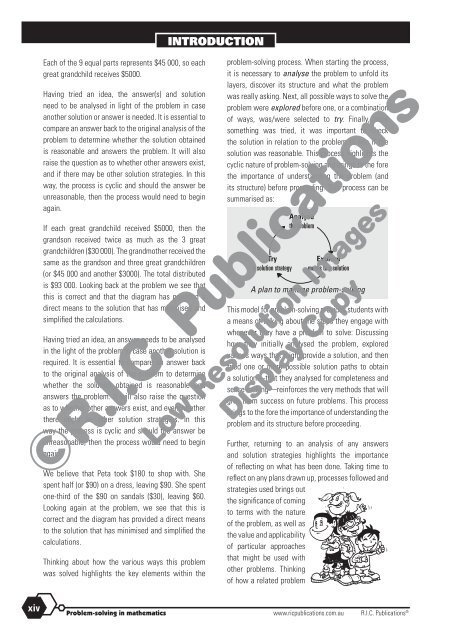20771_Problem_solving_Year_6_Background_information_resources
You also want an ePaper? Increase the reach of your titles
YUMPU automatically turns print PDFs into web optimized ePapers that Google loves.
INTRODUCTION<br />
Each of the 9 equal parts represents $45 000, so each<br />
great grandchild receives $5000.<br />
Having tried an idea, the answer(s) and solution<br />
need to be analysed in light of the problem in case<br />
another solution or answer is needed. It is essential to<br />
compare an answer back to the original analysis of the<br />
problem to determine whether the solution obtained<br />
is reasonable and answers the problem. It will also<br />
raise the question as to whether other answers exist,<br />
and if there may be other solution strategies. In this<br />
way, the process is cyclic and should the answer be<br />
unreasonable, then the process would need to begin<br />
again.<br />
If each great grandchild received $5000, then the<br />
grandson received twice as much as the 3 great<br />
grandchildren ($30 000). The grandmother received the<br />
same as the grandson and three great grandchildren<br />
(or $45 000 and another $3000). The total distributed<br />
is $93 000. Looking back at the problem we see that<br />
this is correct and that the diagram has provided a<br />
direct means to the solution that has minimised and<br />
simplified the calculations.<br />
Having tried an idea, an answer needs to be analysed<br />
in the light of the problem in case another solution is<br />
required. It is essential to compare an answer back<br />
to the original analysis of the problem to determine<br />
whether the solution obtained is reasonable and<br />
answers the problem. It will also raise the question<br />
as to whether other answers exist, and even whether<br />
there might be other solution strategies. In this<br />
way the process is cyclic and should the answer be<br />
unreasonable, then the process would need to begin<br />
again.<br />
We believe that Peta took $180 to shop with. She<br />
spent half (or $90) on a dress, leaving $90. She spent<br />
one-third of the $90 on sandals ($30), leaving $60.<br />
Looking again at the problem, we see that this is<br />
correct and the diagram has provided a direct means<br />
to the solution that has minimised and simplified the<br />
calculations.<br />
Thinking about how the various ways this problem<br />
was solved highlights the key elements within the<br />
problem-<strong>solving</strong> process. When starting the process,<br />
it is necessary to analyse the problem to unfold its<br />
layers, discover its structure and what the problem<br />
was really asking. Next, all possible ways to solve the<br />
problem were explored before one, or a combination<br />
of ways, was/were selected to try. Finally, once<br />
something was tried, it was important to check<br />
the solution in relation to the problem to see if the<br />
solution was reasonable. This process highlights the<br />
cyclic nature of problem-<strong>solving</strong> and brings to the fore<br />
the importance of understanding the problem (and<br />
its structure) before proceeding. This process can be<br />
summarised as:<br />
A plan to manage problem-<strong>solving</strong><br />
This model for problem-<strong>solving</strong> provides students with<br />
a means of talking about the steps they engage with<br />
whenever they have a problem to solve: Discussing<br />
how they initially analysed the problem, explored<br />
various ways that might provide a solution, and then<br />
tried one or more possible solution paths to obtain<br />
a solution—that they analysed for completeness and<br />
sense making—reinforces the very methods that will<br />
give them success on future problems. This process<br />
brings to the fore the importance of understanding the<br />
problem and its structure before proceeding.<br />
Further, returning to an analysis of any answers<br />
and solution strategies highlights the importance<br />
of reflecting on what has been done. Taking time to<br />
reflect on any plans drawn up, processes followed and<br />
strategies used brings out<br />
the significance of coming<br />
to terms with the nature<br />
of the problem, as well as<br />
the value and applicability<br />
of particular approaches<br />
that might be used with<br />
other problems. Thinking<br />
of how a related problem<br />
xiv<br />
<strong>Problem</strong>-<strong>solving</strong> in mathematics www.ricpublications.com.au R.I.C. Publications ®


















